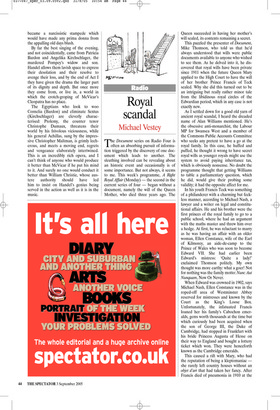Royal scandal
Michael Vestey
The Document series on Radio Four is often an absorbing pursuit of information triggered by the discovery of one document which leads to another. The sleuthing involved can be revealing about an historic event and occasionally is of some importance. But not always, it seems to me. This week’s programme, A Right Royal Affair (Monday) — the second in the current series of four — began without a document, namely the will of the Queen Mother, who died three years ago. The Queen succeeded in having her mother’s will sealed, its contents remaining a secret.
This puzzled the presenter of Document, Mike Thomson, who told us that he’d always understood that wills were public documents available to anyone who wished to see them. As he delved into it, he discovered that royal wills have been private since 1911 when the future Queen Mary applied to the High Court to have the will of her brother Prince Francis of Teck sealed. Why she did this turned out to be an intriguing but really rather minor tale from the libidinous royal circles of the Edwardian period, which in any case is not exactly new.
As I settled down for a good old yarn of ancient royal scandal, I heard the dreaded name of Alan Williams mentioned. He’s the obsessive anti-monarchist, the Labour MP for Swansea West and a member of the Commons Public Accounts Committee who seeks any pretext to have a go at the royal family. In this case, he huffed and puffed, he thought it wrong to have secret royal wills as younger royals might use the system to avoid paying inheritance tax, which is obviously nonsense. No doubt the programme thought that getting Williams to table a parliamentary question, which he did, would give their probing some validity; it had the opposite affect for me.
In his youth Francis Teck was something of a philanderer with a charming but feckless manner, according to Michael Nash, a lawyer and a writer on legal and constitutional affairs. He and his brother were the first princes of the royal family to go to a public school, where he had an argument with the maths master and threw him over a hedge. At first, he was reluctant to marry as he was having an affair with an older woman, Ellen Constance, wife of the Earl of Kilmorey, an aide-de-camp to the Prince of Wales who was soon to become Edward VII. She had earlier been Edward’s mistress: ‘Quite a lady!’ exclaimed Thomson politely. My own thought was more earthy: what a goer! Not for nothing was the family motto: Nunc Aut Nunquam, Now Or Never.
When Edward was crowned in 1902, says Michael Nash, Ellen Constance was in the roped-off area of Westminster Abbey reserved for mistresses and known by the Court as the King’s Loose Box. Unfortunately, the infatuated Francis loaned her his family’s Cabochon emeralds, gems worth thousands at the time but which curiously had been acquired when the son of George III, the Duke of Cambridge, had stopped in Frankfurt with his bride Princess Augusta of Hesse on their way to England and bought a lottery ticket which won. They were henceforth known as the Cambridge emeralds.
This caused a rift with Mary, who had the reputation of being a kleptomaniac she rarely left country houses without an objet d’art that had taken her fancy. After Francis died of pneumonia in 1910 at the age of 39 — he was by then the respectable chairman of Middlesex Hospital — Mary and the royal family discovered that he’d left the family heirlooms to Ellen Constance. As it was now 1911, the year that she and her husband George V were to be crowned, it was decided that these scandals — the jewels, the sharing of both Edward VII and Francis Teck by Lady Kilmorey and gambling debts — could not be made public and so the will was sealed; and all subsequent royal wills have gone the same way.
Thomson did manage to see a draft copy of the will; it was among the Kilmorey papers in the Northern Ireland public records office as one of their ancestral seats is Mourne Park in the Mountains of Mourne. In the will Ellen Constance is referred to by Francis as COX. When Thomson consulted the present Earl of Kilmorey, Richard Needham, the former Tory Northern Ireland minister, much of this, apart from rumours about his greatgrandmother, was news to him though he could see instantly that at the time it would have been ‘pretty hot stuff’. He possesses a pair of cufflinks inscribed ‘FT’, clearly Francis Teck, and said cheerfully, referring to his great-grandmother, ‘To get somebody’s cufflinks you’ve got to get close to their shirt.’ As for the emeralds — Queen Mary bought them back for £10,000 and you can see them, according to a jewellery expert, when the Queen wears in public what’s known as the Grand Duchess Vladimir’s tiara.










































 Previous page
Previous page